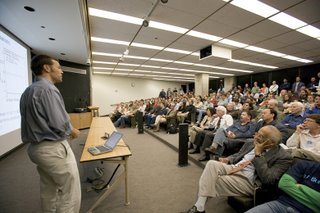B_s meson: Matter to/from Antimatter 3 million times a second
 Christoph Paus of MIT announcing the discovery at Fermilab (photo courtsey: Fermilab)
Christoph Paus of MIT announcing the discovery at Fermilab (photo courtsey: Fermilab)After 2 decades of painstaking research with monumentally precise technology, scientists of the CDF collaboration at the Department of Energy's Fermi National Accelerator Laboratory announced today that they have met the exacting standard to claim discovery of astonishingly rapid transitions of the B_s meson between matter and antimatter 3 trillion times a second.
Immediately after the Big Bang some 13 billion years ago equal amounts of matter and antimatter formed. Much of it quickly acted to annihilate the other, but for little-understood reasons a bit more matter than antimatter survived, providing the universe with the planets, stars and galaxies visible today. Particles that bridge the two worlds, such as the B_s (pronounced B-sub-s) meson, normally don't exist on their own but can be created in the great collisions generated by particle accelerators, which attempt to duplicate conditions close to the Big Bang. Studying the particles helps scientists understand the evolution of the universe.
The B_s meson consists of the heavy bottom quark bound by the strong nuclear interaction to a strange antiquark. The incredibly rapid commuting rate of the B_s meson particle had been predicted by the Standard Model, the successful but still incomplete theory aimed at explaining how matter and energy interact to form the visible universe. The discovery of this oscillatory behavior is thus another reinforcement of the Standard Model's durability.
Many different theoretical models of how the universe works at a fundamental level will now be confronted with the CDF discovery. The currently popular models of supersymmetry, for example, predict a much higher transition frequency than that observed by CDF, and those models will need to be reconsidered.
It must be recalled that scientists at Fermilab also discovered two of the most fundamental particles, the bottom quark in 1977 and in 1995 the top quark, one of the constituent particles of protons, which form the nuclei of atoms.
The results have been submitted in a paper to Physical Review Letters.
Labels: Elementary Particles

0 Comments:
Post a Comment